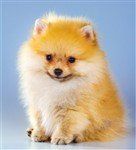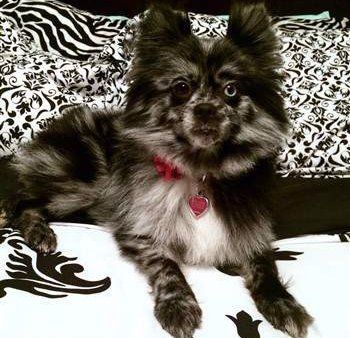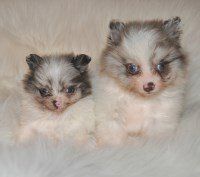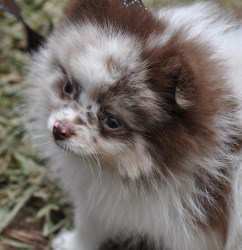Merle
PetPom

The
Pomeranian
Information
Center
Merle Pomeranians
Merle is not a color in and of itself; it is a splashed color pattern with many variations. It is a very interesting color pattern and merle Pomeranians are very sought after in the US. Despite its popularity here, this is not an overly common coloring for this breed because of the very careful breeding that is required to produce a healthy litter.


Wednesday, photo courtesy of Taylor
You won't see this color in many countries since some kennel clubs including the FCI disqualify this coloring pattern.While there is some controversy over this type of coloring both in the US and abroad, there have recently been quite a few AKC show ring champions.
The merle color pattern can be seen on just about any base coat color. Some examples are: blue merle, red merle, white merle and chocolate merle Pomeranians. If a Pom has a coat that is partly solid and then some coat that has this pattern, he is often referred to as a parti-merle. In addition, they may have markings as well; for example a blue merle Pomeranian with tan markings.
Markings are not always present, but if they are they are most often seen on the under belly, chest, neck and legs. There are so many variations that one merle Pom can and often does look completely different than another one.
Whether a Pomeranian has merle over his whole coat or it is on part of the coat, the
fur that has this color pattern will have a speckled or mottled appearance. The merle colors may consist of several other colors and are usually darker colors than the base color of the Pom.
Another important element is the eye coloring
and skin color that goes along with this. The gene that creates this color will affect the dark pigment in the Pom’s eyes… They will may be a gorgeous light blue, a shiny dark sapphire or a light to medium brown with indigo specks.
The nose and paw pads are often a pattern of speckles of pink and black that is quite unique. See also, Parti colored noses on a Pomeranian.

Parti merles; two 6-week-old female Poms. The merling gene is in these Poms eyes and noses.
Photo courtesy of Keen Pomeranians

Tan merle; it's it amazing how the color falls perfectly on the forehead and then is splattered and speckled over the flanks?
Photo courtesy of Sharp Poms

This is a gorgeous parti merle. The merle coloring is brown and this has landed on the nose as well, so one may refer to this as white with chocolate merle.
Kujo, photo courtesy of Erika
How This is Produced - There is much to explain regarding this color….
Each color found in a Pom is created by a gene. Some are dominant and will over power others…some are recessive. Merle is a dominant gene. Therefore, in order for there to be a Merle Pomeranian puppy, that pup must have at least 1 parent who carries the gene.
There is a reason why it is not a good idea for BOTH dam and sire to have this in their genetics!
2 Merles should not be bred together because there are some genetic medical issues that are associated with the relative gene. This includes hearing issues (sometimes severe), eye problems and with males, sometimes a severe reduction of the production of sperm.

(continued below)
-min-335x266-1920w.jpg)
Pumba, photo courtesy of Laura Montanez
When 2 are paired together, the results will be one of the following:
- White Poms: A large majority will be deaf and or blind
- Doubles (MM): These puppies will often have eye problems, be blind and or deaf
- When breeding, one should be aware of the what the following means:
- MM: This is a Merle Pomeranian that is the product of 2 Merle parents (STRONGLY NOT RECOMMENDED)
- Mm: This is a Pom that has 1 parent that has Merle in their bloodline (Recommended)
- mm: This is a Pom that does not carry the gene.
When breeding to produce this coloring, it is important to have dam and sire checked for any hidden merle that may lie somewhere in their bloodline.
This is to ensure that only 1 parent carries it. It can be hidden in any potential dam or sire…their coat may not show it at all.
Therefore, if one is unsure, one should have genetic testing performed before any pairing is done.
Another element to consider is that some colors and patterns can create hidden merle puppies. Therefore, a Merle Pomeranian should not be breed to a sable, cream, ee/recessive red, brindle, piebald or excessive white spotting.
If you already have a merle Pom, certainly take some time to look through this site for all of the information you need regarding care, grooming, feeding, behavior and more.
-300x235.dm.edit_j0quuJ-1920w.jpg)
Adult blue merle Pomeranian. This is an exceedingly rare colored Pom because merle is rare and blue (being a dilute black) is also rare. To have a Pom be merled with blue is exceptional. Photo courtesy of Hertzberg's Lil' Darlings.
Photos & Much More Information
Would you like to see:
- Photos of every color in the 19 AKC list of Pomeranian colors
- Photos of colors that you do not see on the AKC list of colors, but breeders do have on their AKC applications
- How to breed for certain colors?
- We have all of this for you in the PetPom book (NOW IN PRINT).
Take a peek!
You May Also Like
Top 10 Pomeranian Care Tips
- What every owner should be doing for optimal health, comfort, safety, and happiness.
If you email photos to us, you agree that PetPom is given free copyright to use at our discretion. We will always credit the photo to the name of the Pom's owner(s) if it is supplied.
Email: Contact@PetPom.com
All text, images and artwork protected by US and International copyright laws. All rights reserved. Copyright PetPom.com
We are a participant in the Amazon Services LLC Associates Program, an affiliate advertising program designed to provide a means for us to earn fees by linking to Amazon.com and affiliated sites.
